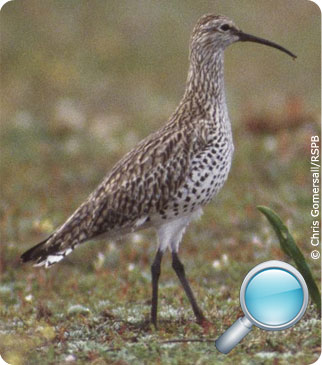|
|
 |
|
Slender-billed Curlew facts
The Slender-billed Curlew (Numenius tenuirostris) is a medium sized wader, one of 6 species of curlews that exist on our planet today. It used to breed in SW Siberia where, in the period 1909-1924, a few nests were found. Since then no one has managed to find a single nest.
After the completion of the breeding period, Slender-billed Curlews migrated 5,000-6,000 km through SE Russia and SE Europe to winter in North and North-West Africa, mainly Morocco. Smaller numbers appeared to winter along the Persian Gulf.
In parts of North Africa and the Mediterranean during the second half of the 19th Century and up to the 1920's the Slender-billed Curlew was an abundant species, occurring in larger numbers than the Eurasian Curlew (Numenius arquata) and the Whimbrel (Numenius phaeopus).
Without any known reason the population started to decrease rapidly. In the last 30 years the decrease has been so dramatic that, today, the Slender-billed Curlew has the sad privilege of being the rarest curlew in the world. The estimate of the world population is between 50-200 birds. The IUCN has listed the species as globally 'Critically Endangered'. At the same time we know very little about the birds' biology and its ecological preferences (feeding behaviour, reproductive behaviour, habitat preferences etc.)
During the 1960's several Slender-billed Curlews were wintering in the coastal wetlands of Morocco, the most important site being Merja Zerga Lagoon. Here even in 1994/95 1-5 birds were still present. Since then no birds have been seen in Morocco and this has discouraged even the most optimistic ornithologists. Since then birds have been seen in Sicily (1996), England (1998), Oman (1999), Greece (Evrotas Delta & Mesolongi 1999), Hungary (2001) and - best of all - a flock of 19 birds were seen in Italy in 1995. This was the largest concentration of birds seen in recent years and shows that despite the severe problems faced by the species it was still surviving somewhere between Siberia and the Mediterranean.
The first record of a Slender-billed Curlew in Greece was in Corfu in 1857. Since then 104 observations have been made, showing the world-wide importance of Greece for this species. Most sightings come from the Evros Delta, Porto Lagos Lagoon and the Axios Delta. Most of the birds were seen from late March to mid-May, and during September-October as the birds passed through Greece on their long journey to and from Siberia.
Recently the Royal Society for the Protection of Birds (RSPB), BirdLife partner in the UK, launched a new awareness and satellite tracking scheme for the Slender-billed curlew. Greece - through the Hellenic Ornithological Society (HOS) - is a key player in this new effort and is working with partners in all the range states. In fact the monitoring of this species by Greek ornithologists had begun many years ago with the implementation of Conservation Actions (1988) and a LIFE project (1999).
A Working Group for the Slender-billed Curlew has been created by the HOS, to promote in Greece the international effort to save the most endangered species of bird in Europe. A database has been set up including all known records of the bird and HOS provides all the data from Greece, after records have been evaluated by the Hellenic Rarities Committee (HRC) and the Scientific Committee of the HOS.
The database is presented on this website and will make a useful tool for birdwatchers and ornithologists who will participate in searching for and tracking the species in Greek wetlands. The search begun in Spring 2009 and is monitored by the Working Group. In brief the basic aim is to make people more aware of the Slender-billed Curlew, help birdwatchers ensure that there is more thorough coverage of the wetlands (especially those where the curlews were seen most regularly) and provide identification material to assist people in looking for Slender-billed Curlews.
We are at a point when the species is in urgent need of help. The location of even a single individual is an extremely important event. If you are confident that you have seen a Slender-billed Curlew you need to act fast. Avoid disturbing the bird, but try to get a video of it or a digital image or a photograph of it. If possible record its call, note its behaviour and, particularly, note down exactly where and when you saw the bird. If you do not find any Slender-billed curlews it is still very useful if you could count any Eurasian curlews and Whimbrels you see. Finally please note down the optical equipments you have used e.g. x10 binoculars, 20-60 x telescope.
Please report any potential Slender-billed Curlew you see AS QUICKLY AS POSSIBLE to the Working Group. The HRC will check your record and the team on stand-by to put a satellite tag on the bird will be informed straight away. By placing a light weight satellite tag on the birds' leg the scientists will be able to track the bird through the migration, wintering and breeding seasons - so we can finally find the critical habitats of this endangered species.
The Hellenic Working Group for the Slender-billed Curlew
Stratis Bourdakis
Giorgos Handrinos
Stavros Kalpakis
Thanos Kastritis
Maria Panayiotopoulou
Nikos Probonas
Lefteris Stavrakas
Yannis Tsougrakis
|
|
|
|
Hellenic Working Group for the Slender-billed Curlew
 |
Hellenic Ornithological Society
The Hellenic Rarities Committee |

